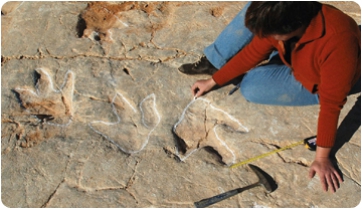ICP News
Trace fossils discovered of an unknown reptile species existing 247 million years ago
19 Apr 2017
1911 times
A team of researchers from the Department of Geology at the Universitat Autònoma de Barcelona (UAB) and the Institut Català de Paleontologia Miquel Crusafont (ICP) recently published in PLOS ONE the description of a large set of tracks made by archosauromorphs, reptiles which later evolved into crocodiles and dinosaurs. Among…
The researchers Kelsey Pugh (City University of New York) and Miyuki Kagaya (Hiroshima University) are visiting the ICP this week to study several fossils from the Institute's collection. Pugh works on the systematics of the Miocene hominoids while Kagaya studies the functional morphology of the upper limbs of apes. Some…
The scientific journal on paleontology Comptes Rendus Palevol has published a thematic issue that includes several articles on Oligocene and Miocene faunas from different regions of Eurasia. Isaac Casanovas, researcher at the Institut Català de Paleontologia Miquel Crusafont (ICP), is one of the guest editors of this special volume that…
The head of the research group on Neogene and Quaternary faunas at the Institut Català de Paleontologia Miquel Crusafont (ICP), David M. Alba, is, since early this year, the new co-editor-in-chief of the Journal of Human Evolution (JHE), the most prestigious scientific journal in the field of human evolution and…
A fortuitous finding provides first evidence for the presence of a Permian captorhinid reptile in Southern Europe. Belongs to a group of early reptiles which is characterized by the possession of several distinctive tooth rows. Catalan and German researchers collaborated in the study of the fossil, which will be housed…
Researchers from the Universitat Autònoma de Barcelona (UAB) and the Institut Català de Paleontologia Miquel Crusafont (ICP), have discovered in Vallcebre (Barcelona) an impression fossil with the surface of the skin of a dinosaur from the Late Cretaceous, a period right before their extinction. Its characteristics make it a unique…
An investigation in a quarry at Vale de Meios (Portugal) has revealed more than 80 tracks belonging to carnivorous dinosaurs of the Megalosauridae group. The 700 footprints found are the largest in the Iberian peninsula and could belong to a small number of individuals that consistently fished in the area…
More than 300 years after its extinction, an international team of researchers has published the first three-dimensional online atlas of the skeleton of this flightless bird, an icon among extinct species in recent human history. Despite its presence in popular culture, little is known we know about the anatomy of…
Researchers from the Universitat Autònoma de Barcelona (UAB), the Miquel Crusafont Catalan Institute of Palaeontology (ICP), and the Jaume Almera Institute of Earth Sciences (CSIC), working in the Manyanet Valley (Pallars Jussà, Lleida), have identified various tracks made by tetrapod animals between 280 and 290 million years ago, which makes…
The analysis of a dinosaur trackway from the Barranco de la Canal (La Rioja) site reveals an injury in the left foot of an ornithopod dinosaur. The animal performed an abnormal gait probably due to the pain caused by the pathology. The investigation was led by researchers at the ‘Institut…
















